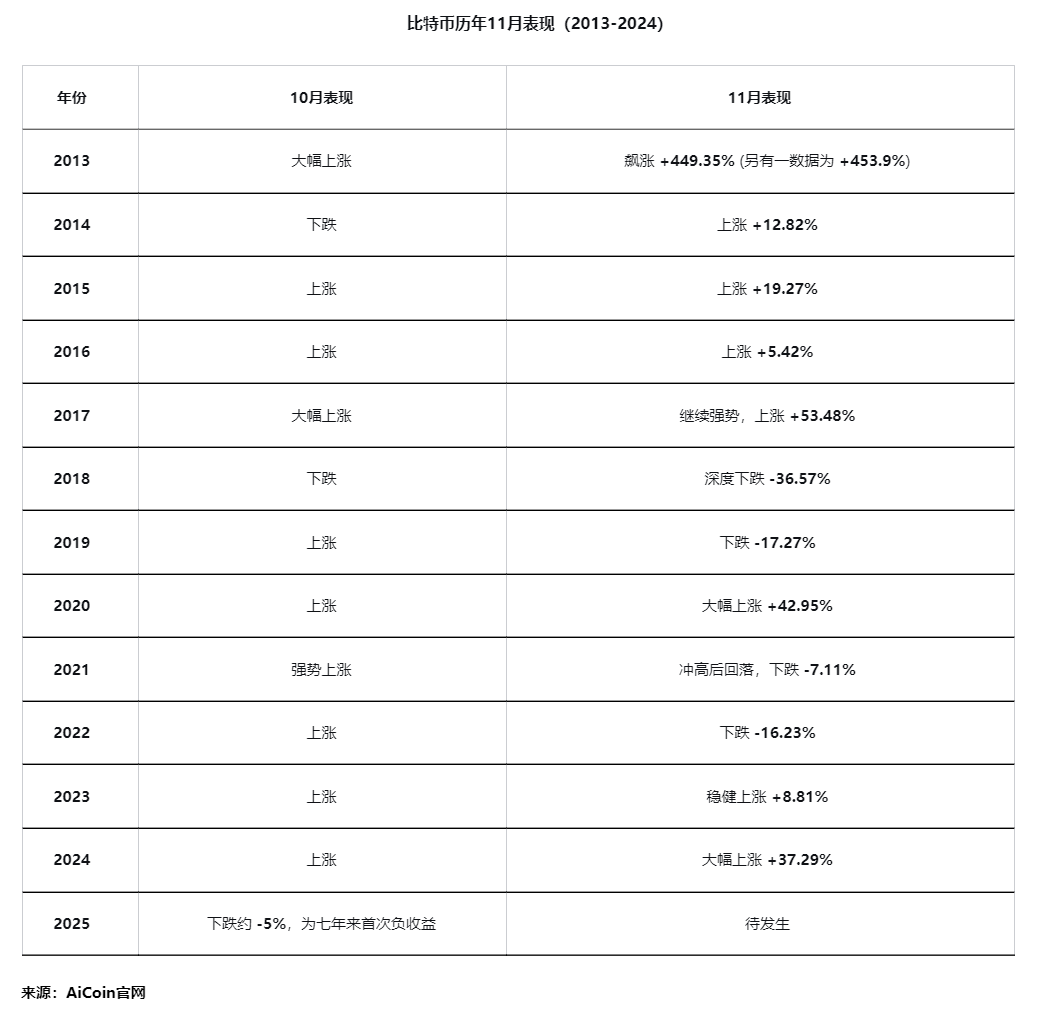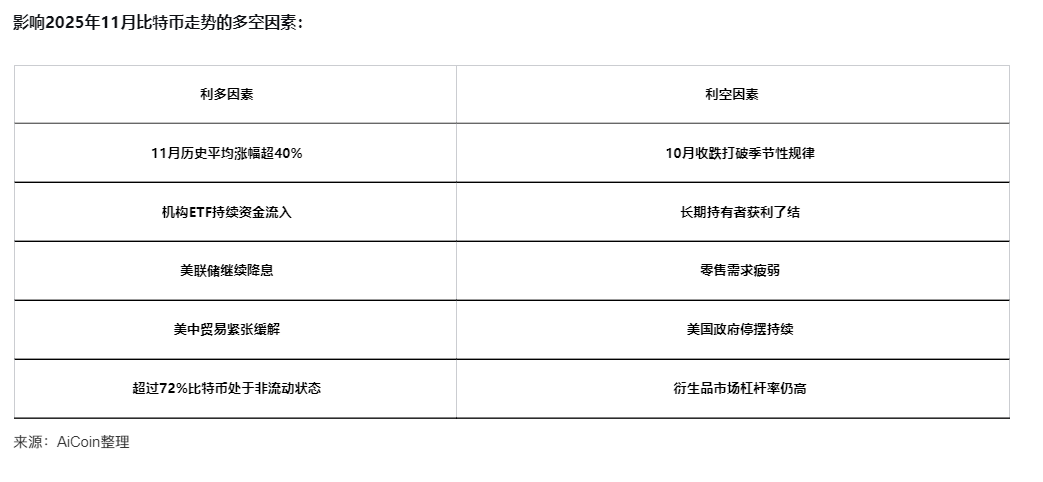Bitcoin fell nearly 5% in October, breaking the “Uptober” rally spell for the first time in seven years, with the market now focusing on whether November’s historical patterns will hold true. Bitcoin recorded a decline of about 4% in the just-ended October, marking the first break of the “Uptober” rally since 2018. This trend was mainly influenced by Trump’s tariff policies on China sparking market panic, profit-taking by long-term holders, and the US government shutdown, among other factors.

I. Breaking the October Spell
In October 2025, Bitcoin broke the seven-year “Uptober” uptrend, closing the month down nearly 4%, making it the worst-performing October since 2018.
● Throughout October, Bitcoin retreated from a high of $125,000 at the start of the month, hitting a low of $104,782.88 between October 10-11, and then hovered below $110,000 at month’s end.
● This performance ended the popular “Uptober” superstition among crypto investors—over the past 12 years, Bitcoin closed higher in October 10 times, with a win rate as high as 83%.

II. Why Is the Market Under Pressure?
Tariff Shock and Market Liquidation
● The market turning point in October occurred on October 11, when US President Trump announced a 100% tariff on Chinese imports and threatened export controls. This news triggered a historic large-scale liquidation in the crypto market, with single-day liquidations reaching as high as $19 billion, causing Bitcoin’s price to plummet by over 10% in a very short time.
● Adam McCarthy, Senior Research Analyst at digital market data provider Kaiko, commented: “The washout on the 11th really reminded people that this asset class is very narrow—even Bitcoin and Ethereum can still see a 10% pullback in 15-20 minutes.”
Profit-Taking by Long-Term Holders
● On-chain data shows that long-term holders (LTH) have been selling Bitcoin since July 1. According to analyst Axel Adler Jr., these investors have distributed about 810,000 BTC, reducing their total holdings from 15.5 million to 14.6 million.
● Despite this selling pressure, Bitcoin still hit a new all-time high of $126,210 on October 7, indicating that market demand was strong enough to absorb the large supply.
Macro Uncertainty Looms
● The US Federal Reserve delayed market expectations for further rate cuts this year, and the US government shutdown prevented the release of key economic data, leaving investors uncertain about the global monetary policy path.
● Meanwhile, several influential figures expressed concerns about overvalued stock markets. JPMorgan CEO Jamie Dimon warned earlier this month that the risk of a major correction in the US stock market would intensify over the next six months to two years.
III. Historical Performance in November
Despite the disappointing performance in October, historical data suggests that November could be a strong month for Bitcoin.
● According to AiCoin data, since 2013, Bitcoin has seen 8 rises and 4 declines in November, with an average return as high as 46.02%. This average is significantly boosted by the extraordinary 449.35% surge in 2013. Excluding this outlier, the average return drops to about 9.35%, with a median return of 10.82%, which better represents typical performance.

Trader Daan Crypto Trades pointed out that November and December have historically been important market turning points. These months have witnessed cycle peaks in 2013, 2017, and 2021, as well as cycle lows in 2018 and 2022.
IV. Intertwined Bullish and Bearish Factors
Positive Signals Remain
Despite the poor performance in October, several positive factors continue to support the market:
● Institutional funds continue to buy despite volatility. In the third quarter, net inflows into Bitcoin spot ETFs reached $7.8 billion. Although this is lower than the $12.4 billion in the second quarter, the sustained net inflows throughout the third quarter confirm stable institutional buying. The first week of October even saw a net inflow of $3.2 billion, setting a new single-week inflow record for 2025.
● Meanwhile, listed company MicroStrategy continued to buy during the market pullback, purchasing 220 Bitcoins on October 13 and 168 Bitcoins on October 20, for a total of 388 Bitcoins in one week.
● On-chain indicators also show good market health. Unrealized losses near $107,000 account for only about 1.3% of Bitcoin’s market cap, far below levels seen in previous bear markets.
Macro Factors Are Key
Bitcoin’s trend in November 2025 will depend on the evolution of several macroeconomic factors:
● Federal Reserve Policy: At the end of October, the Fed cut rates by 25 basis points, bringing the key lending rate to a three-year low. However, Fed Chair Jerome Powell poured cold water on expectations for further rate cuts, saying a December cut is “not a done deal.”
● US Government Shutdown: The US government shutdown has entered its fifth week, nearing the longest record in US history. The ongoing deadlock between Republicans and Democrats over government spending has created uncertainty.
● US-China Trade Relations: Talks between the US President and the Chinese President are seen as a positive step toward easing trade tensions. The agreement includes the US lowering tariffs on Chinese goods in exchange for Beijing cracking down on fentanyl trade.
Market Structure Changes
The market crash on October 11 proved that the Bitcoin market has shifted from retail-dominated to institutionally dominated.
Unlike the retail-driven panic at the end of 2021, this correction was limited in scale. After large-scale liquidations, institutional investors continued to buy, indicating that institutions are firmly defending the market’s downside.

V. Divergent Expert Opinions
Market analysts are divided on Bitcoin’s outlook for November:
● GIS Mining CEO Vasily Girya stated that between October 31 and November 9, Bitcoin may continue to trade in a wide range between $102,000 and $122,550. He noted: “The current price around $110,000 reflects a balance between cautious investor optimism and ongoing macroeconomic uncertainty.”
● 10x Research analyst Markus Thielen emphasized that when analyzing seasonal charts, other influencing factors must be considered. He suggests focusing on developments in US-China trade relations, Fed policy, and the resolution of the US government shutdown.
● Technical analyst Bitcoin Vector pointed out that every time Bitcoin tests the $106,000-$108,000 range, volatility decreases, which is a sign of market resilience. However, the company noted that Bitcoin needs to quickly reclaim the holder cost basis area to prevent renewed downward pressure.
VI. Investment Strategy Recommendations
Short-term traders should focus on key price levels.
● According to GIS Mining CEO Vasily Girya’s analysis, $106,000 is a key support level. If breached, it could trigger a new round of margin position liquidations and accelerate a pullback to the psychologically important $100,000-$102,000 area.
● On the upside, if Bitcoin manages to hold above $111,700, this will pave the way for a retest of the local high at $115,900, and then the all-time high at $126,199.
● For long-term investors, the current environment is still favorable for accumulation. Institutional adoption is accelerating Bitcoin’s integration into traditional finance.
November’s historical performance gives the market hope, but the uniqueness of 2025 lies in the fact that macro factors have surpassed seasonal patterns to become the key forces dominating short-term prices. If Bitcoin can successfully hold the critical support at $110,000, while US-China trade tensions do not escalate further, combined with November’s historically strong performance, Bitcoin may still challenge higher price levels before the end of the year.

